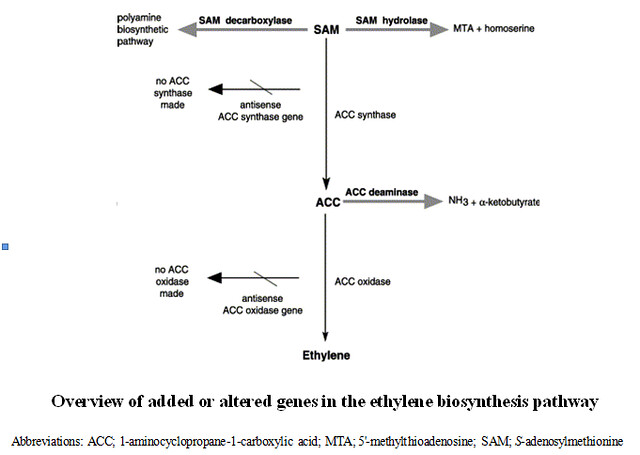Author: Sukumar Taria1
1Ph.D Scholar, Division of Plant Physiology, Indian Agricultural Research Institute, New Delhi- 110012
Email-kuna.sj@gmail.com
Introduction
In most species, fruit growth can be represented by a sigmoid curve or a double sigmoid curve with a second burst of growth during the ripening period while kiwi fruit follows a triple sigmoid growth curve. Physiologically and biochemically, fruit development can be divided into four phases. Among them phase-IV constitute the ripening phases which is otherwise known as early phase of senescence. This ripening process render the fruit attractive and palatable. Among the plant hormone, ethylene enhance the ripening process and exhibit a climacteric rise.
1901: Dimitry Neljubov- Ethylene from coal gas
1910- H.H. Cousins- Ethylene is a natural product of plant tissue.
1935: R. Gane- Ethylene is a natural product of plant tissue.
STRUCTURE, BIOSYNTHESIS AND MEASUREMENT OF ETHYLENE
STRUCTURE: Ethylene is the simplest olefin having molecular weight 28KDa. It is lighter than air under physiological conditions and readily undergone oxidation.
Biosynthesis: Ethylene is synthesized by Yang cycle. The amino acid methionine is the precursor of ethylene. The rate limiting step in ethylene biosynthesis is conversion of S-adenosyl-methinine to ACC (1-aminocyclopropane-1carboxylic acid) which is catalysed by the enzyme ACC synthase. The last step in ethylene biosynthesis is the the conversion of ACC to ethylene, require oxygen and this step is catalysed by ACC oxidase. The CH3-S group of methionine is recycled through yang cycle, thus conserved for continued synthesis.


INHIBITORS OF ETHYLENE BIOSYNTHESIS:
• Aminoethoxyvinylglycine ( AVG) and Aminooxyacetic acid (AOA) are the inhibitors of ACC synthase.
• alpha-aminoisobutyric acid and cobalt ions (Co2+) are the inhibitors of ACC oxidase.
INHIBITORS OF ETHYLENE ACTION: Silver ion ( Ag+) applied as silver thiosulphate are the inhibitors of ethylene action.
• Carbon dioxide at high concentration (5-10%) also inhibit the many action of ethylene such as induction of ripening.
• trans-cyclooctene is the competitive inhibitor of ethylene binding.
• 1-methylcyclopropene (1-MCP) binds irreversibly to the ethylene receptors.
Ethylene absorption: Because ethylene gas is easily lost from its tissue of origin and may effect other tissues or organs, ethylene trapping system is used during the storage of fruits, vegetables and flowers. Potassium permanganate (KMnO4) is an effective absorbant of ethylene.
Measurement of ethylene: Gas chromatography is used for measurement of ethylene.
Climacteric and Non-climacteric
All fruits that show a spike of ethylene production and exhibit a characteristic ethylene asociated respiratory rise for a limited period called “climacteric” before the ripening phase which enhance the ripening process by triggering certain changes in fruit like conversion of starch in to free sugar, change in pH, development of aroma, degredation of chlorophyll etc. Such fruits are grouped as climetric fruits. Ex- Apples, bananas, avocardos and tomatos.
In climacteric fruits, two system of ethylene production occurs.
System 1: which acts on vegetative tissue and in which ethylene inhibits its own biosynthesis.
System 2: which occurs in ripening fruits, in which ethylene stimulate its own biosynthesis.
In contrast, fruits such as citrus fruits and grapes do not exhibit the respiration and ethylene production rise are called non climacteric fruits.
CLIMACTERIC FRUITS: Apple, Avocardo, Banana, Fig, Mango, Olive, Peach, Pear, Plum, Tomato.
NON-CLIMACTERIC FRUITS: Cherry, Citrus, Grapes, Pineapple, Strawberry.
PHYSIOLOGICAL EFFECTS OF ETHYLENE
• Triple response of etiolated seeding:
1. Inhibition of elongation of epicotyle
2. Radial swelling
3. Horizontal growth of epicotyle .
• Leaf epinasty.
• Lateral cell expansion.
• Elongation growth of submerged aquatic plant.
• Induces formation of roots and roots hair.
• Promotes femaleness in cucumber.
• Enhances rate of leaf senescence.
• Mediates some defence response in conjugation with jasmonic acid.
• Acts on the abscission layer.
About Author / Additional Info:
Currently, I am in Ph. D student in Plant Physiology. I am working on abiotic stress management.
Image Source: https://upload.wikimedia.org/wikipedia/commons/d/d5/Yang-cycle.png